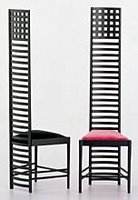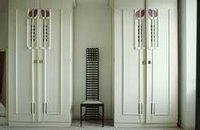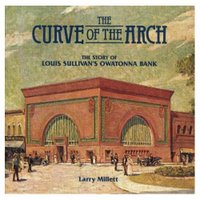
 The famous Mackintosh 'ladder' chair by architect Charles Rennie Mackintosh, left, and there's one in the location for which they were designed, at Hill House, Glasgow, right. (1903)
The famous Mackintosh 'ladder' chair by architect Charles Rennie Mackintosh, left, and there's one in the location for which they were designed, at Hill House, Glasgow, right. (1903)An ornamental bank teller's grille by architect Louis Sullivan below left, and the bank for which the ornament was designed, below right. (1908)
QUESTION: Is the chair, on its own, art? Is the ornamental grille art?

 They're both very nice -- exceptional, in my estimation -- but is there enough in them on their own to be that "shortcut to our most deeply-held premises" which is the defining characteristic of art, particularly good art? Is their sufficient scope in a chair or an example of ornament to perform that role? Or are these things somewhat like a good and well-crafted phrase in a poem, or a peculiarly apt metaphor in a short story, or a telling chapter in a novel: things we can sometimes enjoy in their own right as well -- particularly if we know they came from and are part of the same theme as a major work -- but which we nonetheless know are part of an art work?
They're both very nice -- exceptional, in my estimation -- but is there enough in them on their own to be that "shortcut to our most deeply-held premises" which is the defining characteristic of art, particularly good art? Is their sufficient scope in a chair or an example of ornament to perform that role? Or are these things somewhat like a good and well-crafted phrase in a poem, or a peculiarly apt metaphor in a short story, or a telling chapter in a novel: things we can sometimes enjoy in their own right as well -- particularly if we know they came from and are part of the same theme as a major work -- but which we nonetheless know are part of an art work?In other words, is it true to say that the ensemble is art -- the sum of all the parts -- but not the parts themselves, however attractive?
As they say in Glasgow, "What say you, Jimmy?" (My own answer, if you haven't guessed already, is of course suggested in the questions, but I've sketched it out a little more here and here.)
Oh, and the New York Times has a very brief piece on Sullivan's beautiful series of banks. And antiquarian Eric Knowles does the job for Hill House.
RELATED POSTS ON: Art, Architecture
No comments:
Post a Comment